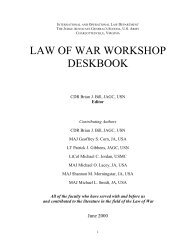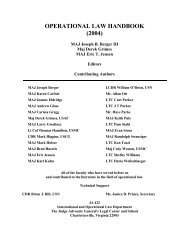learning with professionals - Higgins Counterterrorism Research ...
learning with professionals - Higgins Counterterrorism Research ...
learning with professionals - Higgins Counterterrorism Research ...
You also want an ePaper? Increase the reach of your titles
YUMPU automatically turns print PDFs into web optimized ePapers that Google loves.
terterrorism officials from each of those entities. The proposal for the Center came under<br />
immediate attack from some lawmakers and civil libertarian groups which argued either that<br />
the plan did not go far enough or that it went too far in removing the historic distinctions<br />
between foreign and domestic intelligence. 275 Additionally, some critics insist that no new<br />
structures should be allowed to report solely to the DCI or to the FBI Director, whom they<br />
blame for the security troubles the country is experiencing.<br />
Another cultural divide can be found between the federal level and state and local levels.<br />
Law enforcement has long been executed well by the different levels, and cooperation<br />
between them on domestic criminal activities has generally been excellent. Nevertheless, the<br />
introduction of international terrorism into the equation has taxed the state and local levels. In<br />
most cases, <strong>with</strong> the exception of certain “SWAT” teams and disaster recovery elements existing<br />
in some of the more well-financed jurisdictions (e.g., Fairfax County, Virginia, which has<br />
responded to earthquakes and other disasters around the globe), these units are not trained or<br />
equipped to deal <strong>with</strong> terrorist incidents. Perhaps more troubling is the area of intelligence<br />
sharing. Most of the police departments at these lower levels are not configured to receive or<br />
process classified information, and even those that are often are not accustomed to interpreting<br />
national-level intelligence reports and applying them to local situations.<br />
Nevertheless, serious attempts are being made to close the gap and better integrate the<br />
various levels. For example, last spring President Bush selected New York City’s counterterrorism<br />
chief, Frank Libutti, a retired Marine lieutenant general, for the top intelligencerelated<br />
post at DHS, Undersecretary for Information Analysis and Infrastructure Protection<br />
(IAIP). 276 Interestingly, a high-profile DOD intelligence official had earlier turned<br />
down the job after sending out signals he was interested. Retired Air Force Lieutenant<br />
General James Clapper, former Director of the Defense Intelligence Agency (DIA) and<br />
current Director of the National Imagery and Mapping Agency (NIMA), decided to stay<br />
on at his post at NIMA, where he had been for only about a year. 277 There was some speculation<br />
that Clapper’s decision not to join DHS reflected a broader feeling in DOD, CIA,<br />
and elsewhere in national security circles that the new department was not the place to<br />
ensure continuation of an outstanding intelligence career, though Bush was later successful<br />
in naming some CIA executives to significant homeland security billets. The Agency’s<br />
Deputy Executive Director, John Brennan, was named to head the interagency TTIC<br />
effective 1 May 2003. 278 In addition, a former Agency counterintelligence official who<br />
helped catch CIA spy Aldrich Ames in 1994 was designated DHS Assistant Secretary for<br />
Information Analysis, the division in charge of sifting through databases and other electronic<br />
information to find signs of terrorist activity. 279 On the oversight side, John Gannon,<br />
former Deputy Director for Intelligence at the CIA and subsequently Chairman of<br />
the National Intelligence Council, where he supervised all analysts and the preparation of<br />
275 Dan Eggen and John Mintz, “Agency to Concentrate Intelligence Analysis,” The Washington Post,<br />
30 January 2003, A9.<br />
276 Judi Hasson, “NYC Official Heads to DHS,” Federal Computer Week, 24 March 2003.<br />
277Brian Krebs, “Bush Choice for Security Job Decides Not to Accept It,” The Washington Post, 15 January<br />
2003, E5.<br />
278 Sara Michael, “CIA Veteran Named Threat Center Chief,” Federal Computer Week, 11 March 2003.<br />
279 Judi Hasson, “Bush Names Top Homeland Execs,” Federal Computer Week, 14 March 2003.<br />
148

















